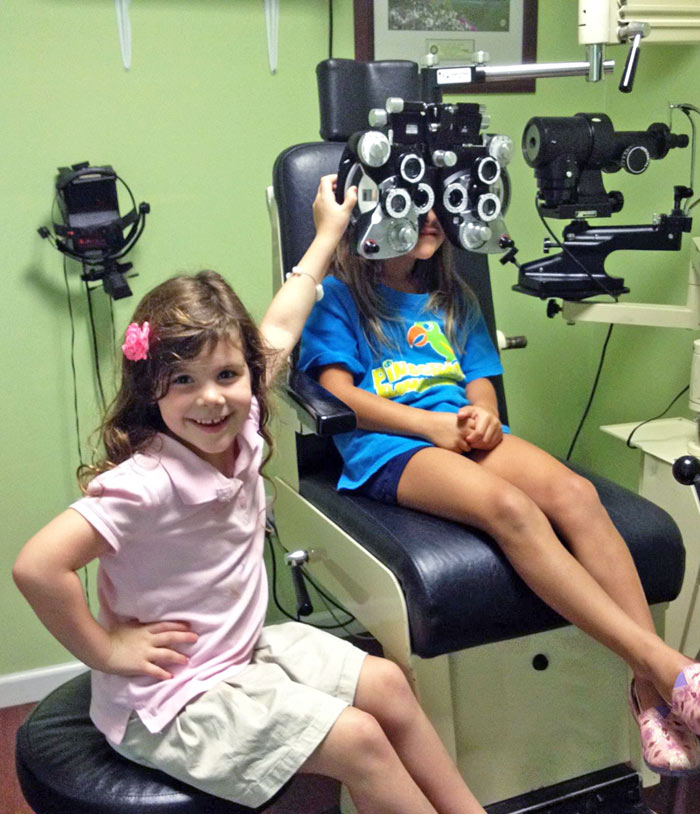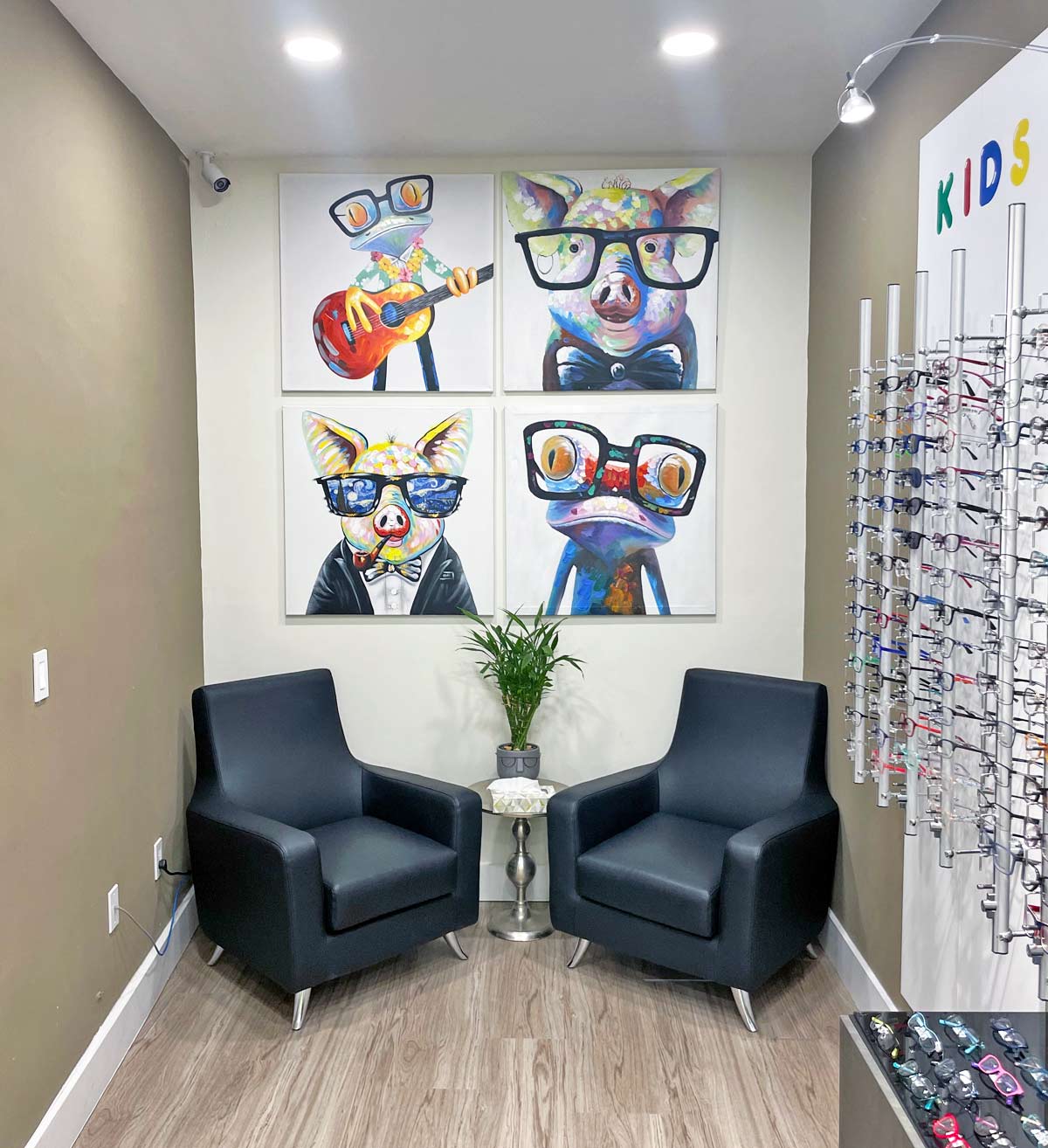Pediatric
Eye Exams
Did you know that up to 80% of classroom learning is visual? If your child has a vision problem, it can affect how they learn and how they perform in school.
In the U.S., one in four children has a vision problem that requires diagnosis and treatment by an eye doctor. Kids aren’t always able to tell you they have a vision problem, which is why regular comprehensive eye health and vision exams are essential for detecting issues early on.
Our pediatric eye doctors in Coral Gables and Palmetto Bay provide expert, personalized eye health and vision care for every member of the family, including children.
How Often Should Children Get Eye Exams?
According to the American Optometric Association (AOA), children should see a pediatric optometrist regularly starting in infancy. Ongoing eye exams help track development, catch vision problems early, and support success in school and beyond.
The AOA recommends the following schedule:
- At 6 months old – Infants should have their first comprehensive eye exam to ensure healthy visual development.
-
At age 3 – A second exam helps monitor eye alignment, focusing ability, and overall visual function.
-
Before starting kindergarten – A third exam checks for any vision issues that could affect learning.
-
Every 2 years during school-age years – If no vision correction is needed.
-
Every year – If your child wears eyeglasses or contact lenses, or as recommended by their optometrist.
What Is Included in a Pediatric Eye Exam?
Our pediatric eye doctors tailor eye exams in Palmetto Bay and Coral Gables based on your child’s age. Every comprehensive exam includes a review of their health history, vision testing, an eye alignment check, and an evaluation of eye health. If needed, the doctor will also prescribe eyeglasses.
Why Are Eye Exams Important for Children?
Children need to have their eyes examined regularly to ensure they are healthy and detect vision problems that may interfere with their performance in school. Eye exams for children assess whether they have the necessary visual skills for learning:
- Excellent vision for near, up-close work, such as reading, and for distance.
- Comfortable and correct “eye teaming,” which means the eyes work well together and can focus on the same place in space.
- Excellent ability to switch the focus from an object up close to an object in the distance.
- Accurate eye movement skills, such as the ability to read a line of text.
School Vision Screenings vs. Pediatric Eye Exams: What’s the Difference?
A vision screening provided by a school nurse is not the same as a comprehensive eye exam. Vision screenings do not diagnose eye or vision problems. They are designed to assess whether a child needs further testing. School vision screenings can also miss up to 75% of children with vision problems.
What are Common Vision Problems in Children?
While this isn’t an exhaustive list, here are some of the most common vision problems in children:
Amblyopia
Also known as “lazy eye,” amblyopia occurs when vision in one eye or both eyes doesn’t develop properly, and it’s a relatively common vision problem in children. It’s important to diagnose and treat amblyopia early to avoid more serious vision issues later on. Amblyopia can be caused by strabismus, ptosis (droopy eyelid), uncorrected refractive errors, or even a cataract.
Astigmatism
The cornea and the lens, which is the front part of the eye, should have a rounded shape curved equally in all directions. Astigmatism occurs when the cornea and the lens have a distorted shape, causing blurry vision when looking at both up-close and distant objects. If a child is diagnosed with astigmatism, they may also have other refractive errors such as myopia and hyperopia.
Convergence Insufficiency
Our two eyes should be able to focus on a single object at near distances. However, with convergence insufficiency, the eyes struggle to focus. Children with undiagnosed convergence insufficiency may avoid reading or other up-close activities.
Hyperopia
Hyperopia, or farsightedness, happens when people can see objects in the distance, such as a blackboard, but have trouble seeing objects up close. Farsighted children may experience headaches or tend to squint when trying to see something in the distance.
Myopia
Myopia, or nearsightedness, is when a person can see objects up close but has problems seeing distant objects, such as a blackboard. Myopia occurs when the cornea, the clear window on the front part of the eye, is too steeply curved.
Myopia often progresses over time and can raise the risk of more serious eye conditions later in life if left untreated. For this reason, it is important to schedule regular pediatric eye exams to catch the condition early on.
Vision Therapy for Children
Some of our doctors provide office-based vision therapy for children with strabismus, amblyopia, and focusing problems, as well as visual rehabilitation after traumatic brain injury at Miami Vision Therapy.
What are the Warning Signs of Vision Problems in Children?
Children may not be able to tell you they have vision problems, so it’s important to be aware of the warning signs. Some early indicators of vision problems in children include the following behaviors:
- Frequent rubbing or blinking of the eyes
- Short attention span or daydreaming
- Poor reading skills
- Avoiding up-close work
- Frequent headaches
- Covering one eye
- Tilting the head when reading
- Squinting one or both eyes
- Placing the head close to the book or the desk when reading or writing
- Poor eye-hand coordination
Schedule a Pediatric Eye Exam in Palmetto Bay or Coral Gables
Remember, children can’t always tell you that they have a vision problem, and vision screenings do not provide the same level of care as a comprehensive eye exam. To ensure your child has healthy eyes and vision, schedule an appointment for a pediatric eye exam in Coral Gables or Palmetto Bay.


